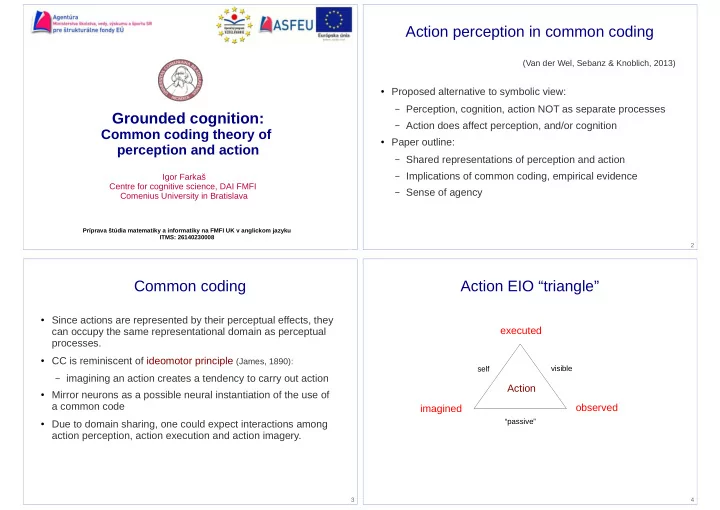

Action perception in common coding (Van der Wel, Sebanz & Knoblich, 2013) ● Proposed alternative to symbolic view: – Perception, cognition, action NOT as separate processes Grounded cognition: – Action does affect perception, and/or cognition Common coding theory of ● Paper outline: perception and action – Shared representations of perception and action – Implications of common coding, empirical evidence Igor Farkaš Centre for cognitive science, DAI FMFI – Sense of agency Comenius University in Bratislava Príprava štúdia matematiky a informatiky na FMFI UK v anglickom jazyku ITMS: 26140230008 1 2 Common coding Action EIO “triangle” ● Since actions are represented by their perceptual effects, they executed can occupy the same representational domain as perceptual processes. ● CC is reminiscent of ideomotor principle (James, 1890): visible self – imagining an action creates a tendency to carry out action Action ● Mirror neurons as a possible neural instantiation of the use of a common code observed imagined ● Due to domain sharing, one could expect interactions among “passive” action perception, action execution and action imagery. 3 4
Action expertise influences action observation Action observation induces action simulation ● shaping auditory perception (tritone paradox) Experiments with ● 2 sessions ● shaping visual perception (badminton, basketball, ballet dance) – recording, ● When do these (better prediction) effects arise? – testing ● EEG evidence (stronger mu-rhythm desynchronization) dart throwing ● ● fMRI evidence: activity in PM and IPL areas scales with handwriting ● competence Better score ● ● Problem with interpretation: not only more motor expertise but for own than other's also more visual expertise (potential confound in explanation). (Knoblich & Flach, 2001) 5 6 Event-related desynchronization (ERD) EEG spectrum during motor actions Executed action Imagined action (Farkas et al, 2011) Motor resonance disrupted Mirror neurons may down modulate motor cortex (leading to mu-rhythm desynchronization) (Trejo, Rosipal, & Matthews, 2006) (Oberman et al, 2007) Mu rhythms: 8-12 Hz 7 8
Constraints for action production in action Fitts's law in action perception observation ● => action production influences action perception and vice versa ● Further support: to show that principles that govern action execution also govern action observation ● 2/3 power law (velocity-curvature inverse rel.) – also in action observation – in prediction of observed actions ● Fitts's law indicates that effects go beyond 2/3 power law – Timing is important (moving between targets) – It applies also for action imagination and action perception => relates to an abstract, representational level of action planning, – Supported by neurological evidence (Grosjean, Shiffrar & Knoblich, 2007) 9 10 Mental state inference via visual feedback Agency and common coding (Oztop, Wolpert, Kawato, 2005) ● How to differentiate b/w execution and perception? ● Apparent mental causation account (Wegner, 2002) ● Role of forward model ● Perceptual accounts (cerebellum) ● Who-system (parietal) (Jeannerod et al.) ● Role of timing cues ● Relative contribution of perceptual cues and sensorimotor cues (Knoblich & Repp, 2007) ● Applies also for action observation? ● Agency in joint actions 11 12
Recommend
More recommend